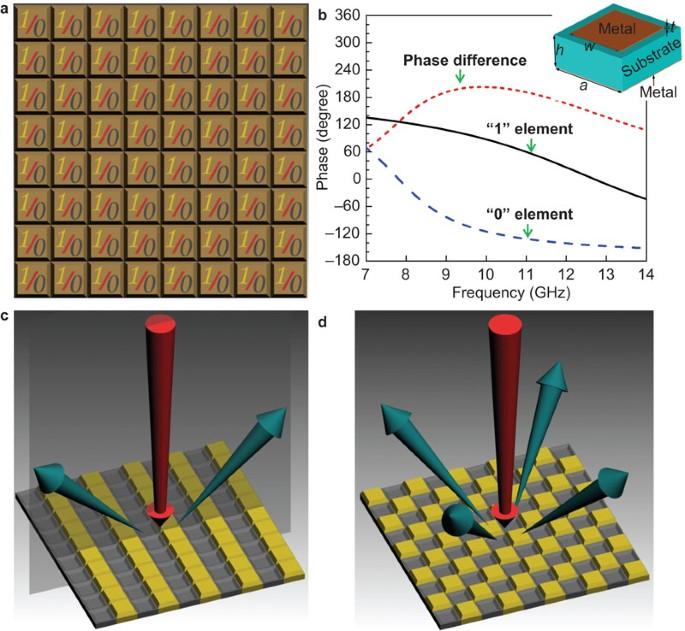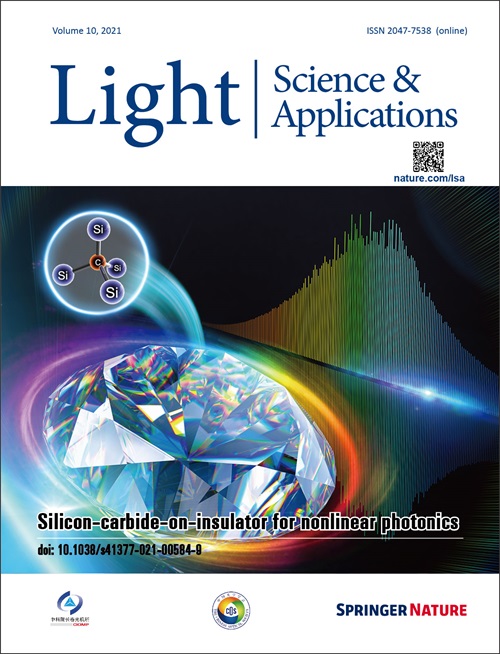Coding metamaterials, digital metamaterials and programmable metamaterials
IF 23.4
1区 物理与天体物理
Q1 Physics and Astronomy
引用次数: 1971
Abstract
Metamaterials are artificial structures that are usually described by effective medium parameters on the macroscopic scale, and these metamaterials are referred to as ‘analog metamaterials’. Here, we propose ‘digital metamaterials’ through two steps. First, we present ‘coding metamaterials’ that are composed of only two types of unit cells, with 0 and π phase responses, which we name ‘0’ and ‘1’ elements, respectively. By coding ‘0’ and ‘1’ elements with controlled sequences (i.e., 1-bit coding), we can manipulate electromagnetic (EM) waves and realize different functionalities. The concept of coding metamaterials can be extended from 1-bit coding to 2-bit coding or higher. In 2-bit coding, four types of unit cells, with phase responses of 0, π/2, π, and 3π/2, are required to mimic the ‘00’, ‘01’, ‘10’ and ‘11’ elements, respectively. The 2-bit coding has greater freedom than 1-bit coding for controlling EM waves. Second, we propose a unique metamaterial particle that has either a ‘0’ or ‘1’ response controlled by a biased diode. Based on this particle, we present ‘digital metamaterials’ with unit cells that possess either a ‘0’ or ‘1’ state. Using a field-programmable gate array, we realize digital control over the digital metamaterial. By programming different coding sequences, a single digital metamaterial has the ability to manipulate EM waves in different manners, thereby realizing ‘programmable metamaterials’. The above concepts and physical phenomena are confirmed through numerical simulations and experiments using metasurfaces. Smart materials offering great freedom in manipulating electromagnetic radiation have been developed. This exciting new concept was realized by Tie Jun Cui and co-workers at the Southeast University, China, who developed digital metamaterials consisting of two kinds of unit cells whose different phase responses allow them to act as ‘0’ and ‘1’ bits. These cells can be judiciously arranged in sequences to enable controlled manipulation of electromagnetic waves. This is one-bit coding; higher-bit coding is possible by employing more kinds of unit cells. The researchers developed a metamaterial cell whose binary response can be controlled by a biased diode. By using a field-programmable gate array, they demonstrated that this digital metamaterial can be programmed. Such metamaterials are attractive for controlling radiation beams in antennas and for realizing other ‘smart’ metamaterials.

编码超材料、数字超材料和可编程超材料
超材料是一种人工结构,通常用宏观尺度上的有效介质参数来描述,这些超材料被称为 "模拟超材料"。在这里,我们通过两个步骤提出 "数字超材料"。首先,我们提出了 "编码超材料",它仅由两种单元单元组成,分别具有 0 和 π 相位响应,我们将其分别命名为 "0 "和 "1 "元素。通过对 "0 "和 "1 "元素进行受控序列编码(即 1 位编码),我们可以操纵电磁波并实现不同的功能。编码超材料的概念可以从 1 位编码扩展到 2 位编码或更高。在 2 位编码中,需要四种相位响应为 0、π/2、π 和 3π/2 的单元,分别模拟 "00"、"01"、"10 "和 "11 "元素。在控制电磁波方面,2 位编码比 1 位编码有更大的自由度。其次,我们提出了一种独特的超材料粒子,它具有由偏置二极管控制的 "0 "或 "1 "响应。基于这种粒子,我们提出了具有 "0 "或 "1 "状态单元的 "数字超材料"。利用现场可编程门阵列,我们实现了对数字超材料的数字控制。通过编制不同的编码序列,单个数字超材料就能以不同的方式操纵电磁波,从而实现 "可编程超材料"。上述概念和物理现象已通过数值模拟和超材料实验得到证实。在操纵电磁辐射方面具有极大自由度的智能材料已经开发出来。中国东南大学的崔铁军及其合作者实现了这一令人兴奋的新概念,他们开发出了由两种单元格组成的数字超材料,这两种单元格的不同相位响应可使它们充当 "0 "和 "1 "位。这些单元可以合理地排列成序列,从而实现对电磁波的可控操纵。这是一位编码;通过采用更多种类的单元格,可以实现更高位的编码。研究人员开发了一种超材料单元,其二进制响应可由偏置二极管控制。通过使用现场可编程门阵列,他们证明了这种数字超材料是可以编程的。这种超材料对于控制天线中的辐射波束和实现其他 "智能 "超材料具有吸引力。
本文章由计算机程序翻译,如有差异,请以英文原文为准。
求助全文
约1分钟内获得全文
求助全文
来源期刊

Light, science & applications
OPTICS-
CiteScore
27.00
自引率
2.60%
发文量
331
审稿时长
20 weeks
期刊介绍:
Light: Science & Applications is an open-access, fully peer-reviewed publication.It publishes high-quality optics and photonics research globally, covering fundamental research and important issues in engineering and applied sciences related to optics and photonics.
 求助内容:
求助内容: 应助结果提醒方式:
应助结果提醒方式:


